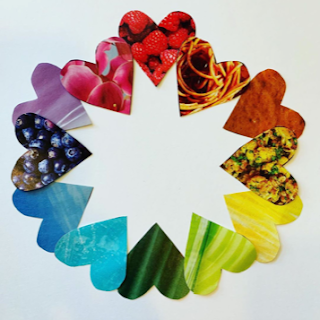Grade 4 - Week 5 - Color Wheel
The Color Wheel
with Ms. Favara
Watch this video to learn about the color wheel
Watch this video to learn the science of color.
StoryBots learn about color.
StoryBots learn about color.
Watch this video about Primary and Secondary colors.
This one is my favorite.
Supplies:
Magazines ( if you don’t have magazines you can use any colored paper)
Glue Stick
Scissors
Pencil, Marker or Pen
2 sheets of printer paper or drawing paper
Key Vocabulary
Color Wheel: a circle with different colored sections used to show the relationship between colors.
Primary Colors: a group of colors from which all other colors can be made by mixing. Red, Yellow and Blue.
Secondary Colors: a group of colors resulting from the mixing of two primary colors. Green, Orange, Violet.
Intermediate Colors: A tertiary color or intermediate color is a color made by mixing one primary color with a secondary color.
Complementary Colors: When placed next to each other, they create the strongest contrast for those two colors. Complementary colors may also be called "opposite colors." These colors are directly opposite each other on the color wheel.
Step 1: Using a piece of paper create a template/view finder for your design. I created a heart as you can see below. You can create any geometric shape like a circle or square or even a star.
Step 2: Use scissors to cut out your template/view finder.
Step 3: Use your view finder to place on top of your magazine pages. This will help you find the colors you are looking for. Once you find the color you are looking for trace your template on the paper and cut it out.
Step 3: Cut out your colors in the shape of your template.
Step 4 : Make sure you have all 12 of your colors.
Red, Red-Orange, Orange, Yellow-Orange, Yellow, Yellow-Green, Green, Blue-Green, Blue, Blue-Violet, Violet, Red-Violet.
Red, Red-Orange, Orange, Yellow-Orange, Yellow, Yellow-Green, Green, Blue-Green, Blue, Blue-Violet, Violet, Red-Violet.
Step 5: Organize your Primary Colors first and lay them out in the triangular shape as you see below. Red, Yellow, and Blue.
Step 6: Next place your Secondary colors in-between. Make sure you pay attention to their placement. In-between Red and Yellow should be the secondary color that they create when you mix them together. If you need a review watch this video again.
Watch this video about Primary and Secondary colors.
This one is my favorite.
Step 7: Now place your Intermediate colors in-between the Primary and Secondary color that creates it. Pay attention to your Complementary colors. They should all be directly opposite each other on your color wheel. For example, opposite violet should be yellow, opposite green should be red, and so on. Do the best you can with placement, but don't worry if it isn't exact.
Step 8: Finally use a glue stick to glue them into place on a piece of white drawing paper.
Have fun and be creative! Here are some other students samples.
If you don't want to create a viewfinder you can just find the colors in the magazines and create your color wheel like this one above.
This one was created using paint instead of using magazines. If you don't have magazines you can create your colors by mixing paint and creating your colors. Then place the colors in the correct order of the color wheel.
We miss you very much!
When you artwork is complete you can keep it in your “art folder” and hang on to it until we complete our program. At the end of the program we will post instruction on how to submit all of your amazing artwork. You do not need to complete the project in one week.
Have fun and be creative!
Ms. Favara












